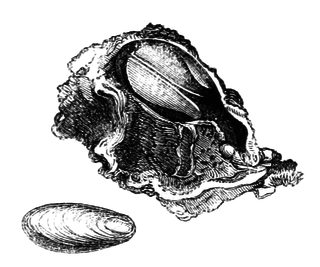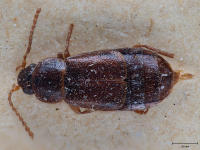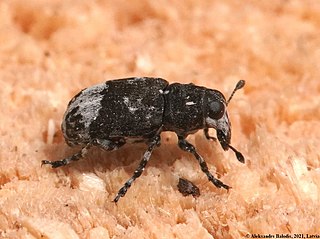Genus is a taxonomic rank used in the biological classification of living and fossil organisms as well as viruses. In the hierarchy of biological classification, genus comes above species and below family. In binomial nomenclature, the genus name forms the first part of the binomial species name for each species within the genus.

The Phrynosomatidae are a diverse family of lizards, sometimes classified as a subfamily (Phrynosomatinae), found from Panama to the extreme south of Canada. Many members of the group are adapted to life in hot, sandy deserts, although the spiny lizards prefer rocky deserts or even relatively moist forest edges, and the short-horned lizard lives in prairie or sagebrush environments. The group includes both egg-laying and viviparous species, with the latter being more common in species living at high elevations.

Achille Valenciennes was a French zoologist.

Siliqua is a genus of saltwater razor clams, marine bivalve molluscs in the family Pharidae, the razor clams and jackknife clams.

Orbiniidae is a family of polychaete worms. Orbiniids are mostly unselective deposit feeders on marine detritus. They can be found from the neritic zone to abyssal depths.

Rocellaria is a genus of saltwater clams, marine bivalve molluscs in the family Gastrochaenidae.

Phyllodocidae is a family of polychaete worms. Worms in this family live on the seabed and may burrow under the sediment.

The Interim Register of Marine and Nonmarine Genera (IRMNG) is a taxonomic database which attempts to cover published genus names for all domains of life from 1758 in zoology up to the present, arranged in a single, internally consistent taxonomic hierarchy, for the benefit of Biodiversity Informatics initiatives plus general users of biodiversity (taxonomic) information. In addition to containing over 490,000 published genus name instances as at March 2020, the database holds over 1.7 million species names, although this component of the data is not maintained in as current or complete state as the genus-level holdings. IRMNG can be queried online for access to the latest version of the dataset and is also made available as periodic snapshots or data dumps for import/upload into other systems as desired.

Eucnecosum is a genus of beetles belonging to the family Staphylinidae.

Evacanthus is a genus of leafhoppers belonging to the family Cicadellidae.

Tropideres is a genus of insects belonging to the family Anthribidae.
Miyakella is a genus of shrimps belonging to the family Squillidae. It is a replacement name for Miyakea Manning, 1995 which was pre-occupied.

Naineris is a genus of annelids belonging to the family Orbiniidae.
Actinodendron is a genus of cnidarians belonging to the family Actinodendridae.

Lepidiota is a genus of beetles belonging to the family Scarabaeidae.

Anomalocardia is a genus of bivalves belonging to the family Veneridae.

Radsia is a genus of chitons belonging to the family Chitonidae.
Lestonia is a genus of true bugs belonging to the monotypic family Lestoniidae.
Fabricia is a genus of polychaetes belonging to the family Fabriciidae.
Oxyuris is a genus of nematodes belonging to the family Oxyuridae.














